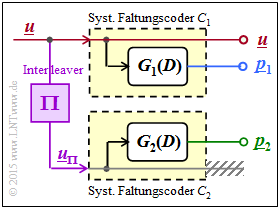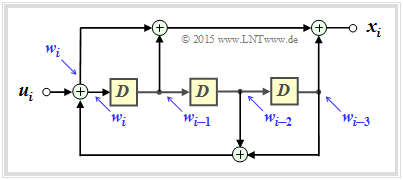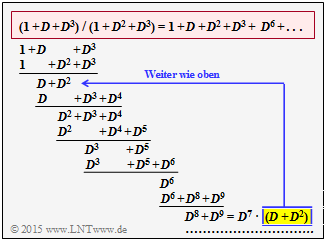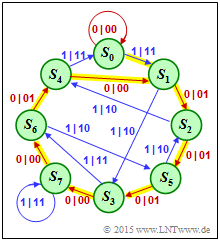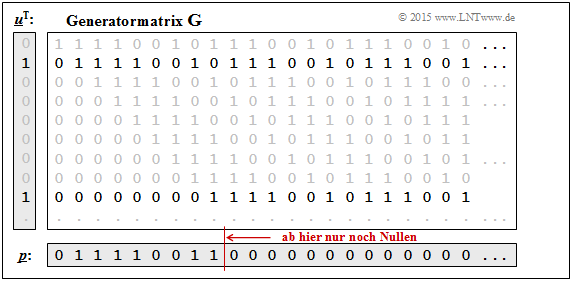Difference between revisions of "Aufgaben:Exercise 4.10: Turbo Encoder for UMTS and LTE"
| Line 1: | Line 1: | ||
| − | {{quiz-Header|Buchseite= | + | {{quiz-Header|Buchseite=Channel_Coding/The_Basics_of_Turbo_Codes}} |
| − | [[File:P_ID3051__KC_A_4_10_v1.png|right|frame|Turbocoder | + | [[File:P_ID3051__KC_A_4_10_v1.png|right|frame|Turbocoder for UMTS and LTE]] |
| − | + | The mobile communications standards [[Mobile_Communications/Characteristics_of_UMTS|"UMTS"]] and [[Mobile_Communications/General_Information_on_the_LTE_Mobile_Communications_Standard|"LTE"]] each use a turbo code that is largely identical to the encoder described in the [[Channel_Coding/The_Basics_of_Turbo_Codes|"The Basics of Turbo Codes"]] chapter. | |
| − | * | + | * The $1/n$ convolutional code is systematic, meaning that the code sequence $\underline{x}$ includes the information sequence $\underline{u}$ as a component. |
| − | * | + | * The parity-check sequences $\underline{p}_1$ and $\underline{p}_2$ are based on the same transfer function: |
:$$G_1(D) = G_2(D) = G(D).$$ | :$$G_1(D) = G_2(D) = G(D).$$ | ||
| − | * $\underline{p}_1$ | + | * $\underline{p}_1$ and $\underline{p}_2$ however, use different input sequences $\underline{u}$ and $\underline{u}_{\pi}$, respectively. Here, ${\rm \Pi}$ marks the interleaver, for UMTS and LTE mostly a $S$ random interleaver. |
| − | [[File:P_ID3052__KC_A_4_10b_v2.png|left|frame| | + | [[File:P_ID3052__KC_A_4_10b_v2.png|left|frame|Given filter structure]] |
| − | <br><br><br><br><br><br> | + | <br><br><br><br><br><br>The main difference compared to the description in the theory part results from a different transfer function $G(D)$ given by the recursive filter structure drawn on the left. |
<br clear=all> | <br clear=all> | ||
| − | + | Hints: | |
| − | * | + | * The exercise belongs to the chapter [[Channel_Coding/The_Basics_of_Turbo_Codes| "Basics of Turbo Codes"]]. |
| − | * | + | * Knowledge is expected about |
| − | ** | + | ** the [[Channel_Coding/Algebraic_and_Polynomial_Description|"Algebraic and Polynomial Description of Convolutional Codes"]], |
| − | ** | + | ** the [[Channel_Coding/Code_Description_with_State_and_Trellis_Diagram|"Code Description with State and Trellis Diagram"]]. |
| − | * | + | * For further guidance on how to do this, see the [[Aufgaben:Exercise_4.08:_Repetition_to_the_Convolutional_Codes|"Exercise 4.8"]] and the [[Tasks:Exercise_4.09:_Recursive_Systematic_Convolutional_Codes|"Exercise 4.9"]]. |
| − | * | + | * The information sequence $\underline{u}$ is partially specified by its $D$–transform for easier description in the subtasks. For example: |
:$$\underline{u}= (\hspace{0.05cm}0\hspace{0.05cm},\hspace{0.05cm} 1\hspace{0.05cm},\hspace{0.05cm} 1\hspace{0.05cm},\hspace{0.05cm} 0\hspace{0.05cm},\hspace{0.05cm} 0\hspace{0.05cm},\hspace{0.05cm}0\hspace{0.05cm},\hspace{0.05cm} 0\hspace{0.05cm},\hspace{0.05cm} 0\hspace{0.05cm},\hspace{0.05cm} 0\hspace{0.05cm},\hspace{0.05cm} 0\hspace{0.05cm}\hspace{0.05cm} \text{...}\hspace{0.05cm}) \quad \circ\!\!-\!\!\!-^{\hspace{-0.25cm}D}\!\!\!-\!\!\bullet\quad | :$$\underline{u}= (\hspace{0.05cm}0\hspace{0.05cm},\hspace{0.05cm} 1\hspace{0.05cm},\hspace{0.05cm} 1\hspace{0.05cm},\hspace{0.05cm} 0\hspace{0.05cm},\hspace{0.05cm} 0\hspace{0.05cm},\hspace{0.05cm}0\hspace{0.05cm},\hspace{0.05cm} 0\hspace{0.05cm},\hspace{0.05cm} 0\hspace{0.05cm},\hspace{0.05cm} 0\hspace{0.05cm},\hspace{0.05cm} 0\hspace{0.05cm}\hspace{0.05cm} \text{...}\hspace{0.05cm}) \quad \circ\!\!-\!\!\!-^{\hspace{-0.25cm}D}\!\!\!-\!\!\bullet\quad | ||
U(D) = D+ D^2\hspace{0.05cm},$$ | U(D) = D+ D^2\hspace{0.05cm},$$ | ||
| Line 29: | Line 29: | ||
| − | === | + | ===Questions=== |
<quiz display=simple> | <quiz display=simple> | ||
| − | { | + | {What are the characteristics of the considered turbo code (memory $m$, influence length $\nu$, rate $R$)? |
|type="{}"} | |type="{}"} | ||
$ m \hspace{0.2cm} = \ ${ 3 3% } | $ m \hspace{0.2cm} = \ ${ 3 3% } | ||
| Line 37: | Line 37: | ||
$R \hspace{0.2cm} = \ ${ 0.333 3% } | $R \hspace{0.2cm} = \ ${ 0.333 3% } | ||
| − | { | + | {What are the (identical) transfer functions $G_1(D) = G_2(D) = G(D)$? |
|type="()"} | |type="()"} | ||
| − | + | + | + $G(D) = (1 + D + D^3)/(1 + D^2 + D^3)$. |
| − | - | + | - $G(D) = (1 + D^2 + D^3)/(1 + D + D^3)$. |
| − | { | + | {What is the impulse response $\underline{g}$ ? |
|type="[]"} | |type="[]"} | ||
| − | - | + | - $\underline{g} = (1, \, 1, \, 1, \, 0, \, 1, \, 1, \, 0, \, 1, \, 1, \, 0, \, 1, \, 1, \, 0, \, 1, \, 1, \hspace{0.05cm} \text{...}\hspace{0.05cm})$ |
| − | + | + | + $\underline{g} = (1, \, 1, \, 1, \, 1, \, 0, \, 0, \, 1, \, 0, \, 1, \, 1, \, 1, \, 0, \, 0, \, 1, \, 0, \hspace{0.05cm} \text{...}\hspace{0.05cm})$. |
| − | + $\underline{g}$ | + | + $\underline{g}$ continues to infinity. |
| − | { | + | {Are there periodic components within the impulse response $\underline{g}$ ? |
|type="()"} | |type="()"} | ||
| − | + | + | + Yes, with the period $P = 7$. |
| − | - | + | - Yes, with the period $P = 8$. |
| − | - | + | - No. |
| − | { | + | {Let $U(D) = D + D^2$. Which statements are true? |
|type="[]"} | |type="[]"} | ||
| − | + | + | + The initial sequence $\underline{p}$ contains a periodic component. |
| − | + | + | + The period $P$ is unchanged from $\underline{g}$ . |
| − | + | + | + The Hamming weight of the input sequence is $w_{\rm H}(\underline{u}) = 2$. |
| − | - | + | - The Hamming weight of the output sequence is $w_{\rm H}(\underline{p}) = 6$. |
| − | { | + | {Which statements are true for $U(D) = D + D^8$ ? |
|type="[]"} | |type="[]"} | ||
| − | - | + | - The initial sequence $\underline{p}$ contains a periodic component. |
| − | - | + | - The period $P$ is unchanged from $\underline{g}$ . |
| − | + | + | + The Hamming weight of the input sequence is $w_{\rm H}(\underline{u}) = 2$. |
| − | + | + | + The Hamming weight of the output sequence is $w_{\rm H}(\underline{p}) = 6$. |
</quiz> | </quiz> | ||
| − | === | + | ===Solution=== |
{{ML-Kopf}} | {{ML-Kopf}} | ||
| − | [[File:P_ID3060__KC_A_4_10c_v3.png|right|frame| | + | [[File:P_ID3060__KC_A_4_10c_v3.png|right|frame|Polynomial division for subtask ''(3)''': $G(D) = (1 + D + D^3) \ / \ (1 + D^2 + D^3)$]] |
| − | '''(1)''' | + | '''(1)''' The code parameters are $k = 1$ and $n = 3$ ⇒ Code rate $\underline{R = 1/3}$. |
| − | * | + | *The memory is $\underline{m = 3}$. |
| − | * | + | *The influence lengths result in $\nu = 1, \ \nu_2 = 4$ and $\nu_3 = 4$ ⇒ Total influence length $\underline{\nu = 9}$. |
| − | '''(2)''' | + | '''(2)''' As the comparison of the [[Channel_Coding/Algebraic_and_Polynomial_Description#Filter_structure_with_fractional.E2.80.93rational_transfer_function|"recursive filter"]] on the data page with the [[Aufgaben:Exercise_4. 10:_Turbo_Enccoder_for_UMTS_and_LTE|"filter structure"]] in the theory section for fractional–rational $G(D)$, the <u>suggested solution 1</u> is correct. |
| Line 154: | Line 154: | ||
''Weitergehende Hinweise:'' | ''Weitergehende Hinweise:'' | ||
* Für einen Turbocode sind insbesondere solche Eingangsfolgen $\underline{u}$, deren $D$–Transformierte als $U(D) = f(D) \cdot [1 + D^{P}]$ darstellbar sind, äußerst ungünstig. | * Für einen Turbocode sind insbesondere solche Eingangsfolgen $\underline{u}$, deren $D$–Transformierte als $U(D) = f(D) \cdot [1 + D^{P}]$ darstellbar sind, äußerst ungünstig. | ||
| − | *Sie bewirken den <i>Error Floor</i>, wie er auf der Seite [[Channel_Coding/ | + | *Sie bewirken den <i>Error Floor</i>, wie er auf der Seite [[Channel_Coding/The_Basics_of_Turbo_Codes#Performance_of_the_turbo_codes|"Leistungsfähigkeit der Turbocodes"]] im Theorieteil zu erkennen ist. |
*$P$ gibt dabei die Periode der Impulsantwort $\underline{g}$ an. | *$P$ gibt dabei die Periode der Impulsantwort $\underline{g}$ an. | ||
*In unserem Beispiel gilt $f(D) = D$ und $P = 7$. | *In unserem Beispiel gilt $f(D) = D$ und $P = 7$. | ||
Revision as of 22:48, 29 November 2022
The mobile communications standards "UMTS" and "LTE" each use a turbo code that is largely identical to the encoder described in the "The Basics of Turbo Codes" chapter.
- The $1/n$ convolutional code is systematic, meaning that the code sequence $\underline{x}$ includes the information sequence $\underline{u}$ as a component.
- The parity-check sequences $\underline{p}_1$ and $\underline{p}_2$ are based on the same transfer function:
- $$G_1(D) = G_2(D) = G(D).$$
- $\underline{p}_1$ and $\underline{p}_2$ however, use different input sequences $\underline{u}$ and $\underline{u}_{\pi}$, respectively. Here, ${\rm \Pi}$ marks the interleaver, for UMTS and LTE mostly a $S$ random interleaver.
The main difference compared to the description in the theory part results from a different transfer function $G(D)$ given by the recursive filter structure drawn on the left.
Hints:
- The exercise belongs to the chapter "Basics of Turbo Codes".
- Knowledge is expected about
- For further guidance on how to do this, see the "Exercise 4.8" and the "Exercise 4.9".
- The information sequence $\underline{u}$ is partially specified by its $D$–transform for easier description in the subtasks. For example:
- $$\underline{u}= (\hspace{0.05cm}0\hspace{0.05cm},\hspace{0.05cm} 1\hspace{0.05cm},\hspace{0.05cm} 1\hspace{0.05cm},\hspace{0.05cm} 0\hspace{0.05cm},\hspace{0.05cm} 0\hspace{0.05cm},\hspace{0.05cm}0\hspace{0.05cm},\hspace{0.05cm} 0\hspace{0.05cm},\hspace{0.05cm} 0\hspace{0.05cm},\hspace{0.05cm} 0\hspace{0.05cm},\hspace{0.05cm} 0\hspace{0.05cm}\hspace{0.05cm} \text{...}\hspace{0.05cm}) \quad \circ\!\!-\!\!\!-^{\hspace{-0.25cm}D}\!\!\!-\!\!\bullet\quad U(D) = D+ D^2\hspace{0.05cm},$$
- $$\underline{u}= (\hspace{0.05cm}0\hspace{0.05cm},\hspace{0.05cm} 1\hspace{0.05cm},\hspace{0.05cm} 0\hspace{0.05cm},\hspace{0.05cm} 0\hspace{0.05cm},\hspace{0.05cm} 0\hspace{0.05cm},\hspace{0.05cm}0\hspace{0.05cm},\hspace{0.05cm} 0\hspace{0.05cm},\hspace{0.05cm} 1\hspace{0.05cm},\hspace{0.05cm} 0\hspace{0.05cm},\hspace{0.05cm} 0\hspace{0.05cm}\hspace{0.05cm} \text{...}\hspace{0.05cm}) \quad \circ\!\!-\!\!\!-^{\hspace{-0.25cm}D}\!\!\!-\!\!\bullet\quad U(D) = D+ D^8\hspace{0.05cm}.$$
Questions
Solution
(1) The code parameters are $k = 1$ and $n = 3$ ⇒ Code rate $\underline{R = 1/3}$.
- The memory is $\underline{m = 3}$.
- The influence lengths result in $\nu = 1, \ \nu_2 = 4$ and $\nu_3 = 4$ ⇒ Total influence length $\underline{\nu = 9}$.
(2) As the comparison of the "recursive filter" on the data page with the "filter structure" in the theory section for fractional–rational $G(D)$, the suggested solution 1 is correct.
(3) Richtig sind die Lösungsvorschläge 2 und 3:
Die obere Grafik verdeutlicht die Polynomdivision $(1 + D + D^3) \ / \ (1 + D^2 + D^3)$. Zur Erläuterung:
- Abgebrochen ist die Darstellung mit dem Rest $D^8 + D^9 = D^7 \cdot (D + D^2)$.
- Damit gilt auch:
- $$(D^8 + D^9) \hspace{0.05cm} /\hspace{0.05cm} (1+ D^2+ D^3 ) \hspace{-0.15cm} \ = \ \hspace{-0.15cm} D^7 \cdot (D+ D^2+ D^3 + D^6) + {\rm Rest_2}$$
- Nach Zusammenfassen:
- $$G(D) = 1 + D + D^2 + D^3 + D^6 + D^8+ D^9+ D^{10} + D^{13} + \hspace{0.05cm}\text{ ... }\hspace{0.05cm} \hspace{0.05cm}. $$
- Die $D$–Rücktransformierte ergibt den Lösungsvorschlag 2:
- $$\underline{g}= (\hspace{0.05cm}1\hspace{0.05cm}, \hspace{0.05cm} 1\hspace{0.05cm}, \hspace{0.05cm} 1\hspace{0.05cm}, \hspace{0.05cm} 1\hspace{0.05cm}, \hspace{0.05cm} 0\hspace{0.05cm}, \hspace{0.05cm} 0\hspace{0.05cm}, \hspace{0.05cm} 1\hspace{0.05cm}, \hspace{0.05cm} 0\hspace{0.05cm}, \hspace{0.05cm} 1\hspace{0.05cm}, \hspace{0.05cm} 1\hspace{0.05cm}, \hspace{0.05cm} 1\hspace{0.05cm}, \hspace{0.05cm} 0\hspace{0.05cm}, \hspace{0.05cm} 0\hspace{0.05cm}, \hspace{0.05cm} 1\hspace{0.05cm}, \hspace{0.05cm} 0\hspace{0.05cm},\hspace{0.05cm}\text{ ... }\hspace{0.05cm})\hspace{0.05cm}. $$
- Die Impulsantwort setzt sich bis ins Unendliche fort ⇒ Lösungsvorschlag 3 ist ebenfalls richtig.
(4) Die Impulsantwort kann wie folgt ausgedrückt werden:
- $$\underline{g}= \Big (\hspace{0.03cm}1\hspace{0.03cm}, \big [ \hspace{0.03cm} 1\hspace{0.03cm}, \hspace{0.03cm} 1\hspace{0.03cm}, \hspace{0.03cm} 1\hspace{0.03cm}, \hspace{0.03cm} 0\hspace{0.03cm}, \hspace{0.03cm} 0\hspace{0.03cm}, \hspace{0.03cm} 1\hspace{0.03cm}, \hspace{0.03cm} 0\hspace{0.03cm} \big ]_{\rm per} \Big ) \hspace{0.15cm}\Rightarrow \hspace{0.15cm} \underline{P = 7} \hspace{0.05cm}. $$
Im Zustandsübergangsdiagramm (rechts) ist die Impulsantwort $\underline{g}$ gelb hinterlegt. Die Impulsantwort ergibt sich als die Paritysequenz $\underline{p}$ für die Informationssequenz $\underline{u} = (1, \, 0, \, 0, \, 0, \, 0, \, \text{ ... })$.
- Die Übergänge im Diagramm sind mit "$u_i\hspace{0.05cm}|\hspace{0.05cm}\underline{x}_i$" beschriftet, was gleichbedeutend ist mit "$u_i\hspace{0.05cm}|\hspace{0.05cm}u_i \hspace{0.05cm}p_i$".
- Die Paritysequenz $\underline{p} \ (=$ Impulsantwort $\underline{g})$ ergibt sich somit aus dem jeweiligen zweiten Coderausgangssymbol.
- $\underline{g}$ wird durch folgende Zustände repräsentiert:
- $$S_0 → [S_1 → S_2 → S_5 → S_3 → S_7 → S_6 → S_4 ] → [S_1 → \ ... \ → S_4] → \ \text{ ... } $$
(5) Die folgende Grafik zeigt die Lösung anhand der Generatormatrix $\mathbf{G}$. Es gilt $\underline{u} = (0, \, 1, \, 1, \, 0, \, 0, \, \text{ ... } )$.
Man erkennt, dass die Lösungsvorschläge 1, 2 und 3 richtig sind:
- Die vorliegende Paritysequenz $\underline{p}$ hat die gleiche Periode $P = 7$ wie die Impulsantwort $\underline{g}$.
- Das Hamming–Gewicht der (begrenzten) Eingangsfolge ist tatsächlich $w_{\rm H}(\underline{u}) = 2$.
- Der Vorschlag 4 ist falsch. Vielmehr gilt hier für die semi–infinite Ausgangssequenz: $w_{\rm H}(\underline{p}) → \infty$.
Im Übergangsdiagramm werden zunächst die Zustände $S_0 → S_0 → S_1 → S_3 → S_7 → S_6 → S_4 → S_1$ durchlaufen. Danach folgt (unendlich oft) der periodische Anteil $S_1 → S_2 → S_5 → S_3 → S_7 → S_6 → S_4 → S_1$.
(6) Die letzte Grafik zeigt die Lösung für $U(D) = D + D^8 \Rightarrow \underline{u} = (0, \, 1, \, 0, \, 0, \, 0, \, 0, \, 0, \, 0, \, 1, \, 0, \, 0, \, \text{ ... })$.
Richtig sind die Lösungsvorschläge 3 und 4:
- Die Eingangssequenz $\underline{u}$ beinhaltet zwei Einsen und die Ausgangssequenz $\underline{p}$ sechs Einsen.
- Ab der Position 10 ist nun die Ausgangssequenz $\underline{p} \equiv\underline{0}$
⇒ die Vorschläge 1 und 2 treffen also nicht zu.
Weitergehende Hinweise:
- Für einen Turbocode sind insbesondere solche Eingangsfolgen $\underline{u}$, deren $D$–Transformierte als $U(D) = f(D) \cdot [1 + D^{P}]$ darstellbar sind, äußerst ungünstig.
- Sie bewirken den Error Floor, wie er auf der Seite "Leistungsfähigkeit der Turbocodes" im Theorieteil zu erkennen ist.
- $P$ gibt dabei die Periode der Impulsantwort $\underline{g}$ an.
- In unserem Beispiel gilt $f(D) = D$ und $P = 7$.
